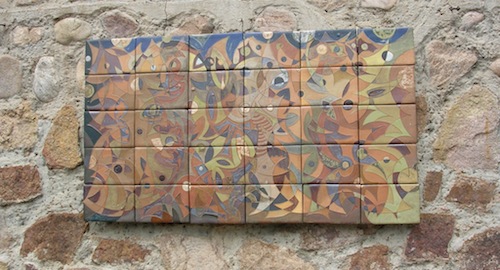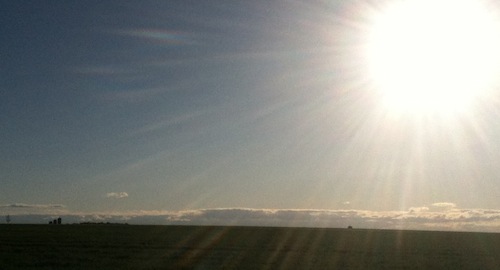Tuesday night as I walked past the door of the room in which the 10 p.m. news was on the television, I heard the meteorologist say that the space station would be visible in our clear western sky starting at 10:22. It was 10:18. If I hadn't just read Leaving Orbit: Notes from the Last Days of American Spaceflight, by Margaret Lazarus Dean, I may not have heard his words. But I did and so immediately walked outside, calling out to my husband to follow me for a space station view. We walked for a couple blocks, me in my slippers, trying to escape streetlights and trees. And there it was, summersaulting across the sky, left to right, bright as a diamond, until it was gone, over other neighborhoods far away.
Leaving Orbit is about the end of the U.S. space program; it's a personal look as well as a deeply researched history. If Mercury was the beginning of our space program, the last take-off and landing of the space shuttle Atlantis was the end. The space station still orbits, but it will now rendezvous with commercial or non-U.S. spacecraft. Throughout the book Dean asks, why are we stopping?
The book was a fascinating read for me. First, it chronicled a daring and exciting period of our history. Second, it spoke of big dreams and big ideas that real men and women actualized in their work. Third, and more personally, it gave me a view into events that formed the backdrop for much of my life. My father was an aerospace engineer and had his hand in many of the projects Dean discusses, but most particularly the shuttle program, for which he was the lead engineer for the flight control system. Reading Dean's book was at times an emotional experience for me, with shuttle having so much to do with my growing up years, particularly those in Florida. It was also an emotional experience because like so many of you reading this now, I can remember sitting in front of the television watching Neil Armstrong take those first steps on the moon.
In Finding Livelihood I have a couple sentences about my father explaining shuttle to me and my brother and sister at the dinner table one night.
"My father was the engineering manager for the flight control systems. For years, long before “shuttle” was a household name or even a public curiosity, I knew what he was working on with his slide rule. He had first told us about it at the dinner table one night. The idea was wild. He rocked his hands in the air to show us the gyroscope action of the flight guidance instruments and then moved them along an upward then descending arc to show how the shuttle would launch like a rocket and land like a plane. He rested one hand on top of the other to show how it would return to the Center for its next launch by riding piggyback on a 747."
I tried to pick a single excerpt from Leaving Orbit to convince you also to read it, but I'm having trouble selecting just one. So there will be more than one.
This:
"Though I'm under forty-five, too young to have seen Neil and Buzz climb out of their lunar module, too young to have witnessed the prime of NASA, I love the idea of spaceflight. I love the audacity of the handsome young president challenging us to to the moon not because it is easy but because it is hard; I love the young scientists and engineers who took his charge as their personal religion and made inestimable sacrifices to meet John Kennedy's challenge after his death. I love the fire and rockets, the thundering wonder of building-sized objects hauling themselves off the launchpads and past the grip of gravity. The badass steeliness and crew cuts of the test-pilot sixties astronauts, the engineers in their short-sleeved dress shirts and dark ties, the technicians in their greasy uniforms. I love the old ladies wearing cat's-eye glasses and drinking tea while they stitch together the seams of the space suits that will be the only barrier between moonwalkers and the sucking black vacuum of space."
And this, where she describes watching, from the vantage point of Cape Canaveral, the last launch of the shuttle Discovery:
"And now the sound comes toward us: bassy, crackly, like a fireworks display that never lets up. The sound goes right through you, and if you have become too emotionally involved in the space program, this sound will make you cry. It's the sound of American exploration, the sound of missiles put to better use than killing or threatening to kill, a sound that means we came in peace for all mankind. The man from Ohio is trying to watch through binoculars and shoot videos of the launch with his phone at the same time; his wife is exclaiming "Oh my God! Oh my God!" over and over. We cry and tip our heads back to trace the bright light up."
(I posted to this blog when Discovery landed after this last flight: see here)
And this, about the people and their work:
"One thing I notice every time I'm at the Cape is how literal all the workers are about their work. I've kept calling the work here some kind of dream, yet what I see over and over is that, to the people who do the work, nothing is a dream, a metaphor, a fairy tale: everything is exactly what it is. If the work here results in something beautiful, it is beautiful by accident, as form follows function. It is the reflected beauty of our inventions I'm seeing, not someone's abstract idea of beauty."
I hope I've convinced you to read it. Leaving Orbit is the winner of this year's Graywolf Press nonfiction prize. (I wrote about last year's winner, The Empathy Exams by Leslie Jamison, here.)
If you receive my newsletter, (click here to subscribe), which is separate from this blog, you'll be hearing from me over the weekend with another perspective on this book and why it inspires the explorer in any of us.
~~~
[Photo: Top, launch of Atlantis, courtesy of NASA; lower, taken of the book next to of one of my numerous shuttle memorabilia.]








